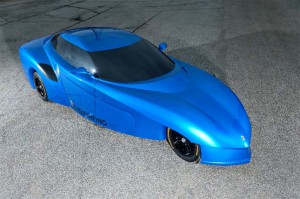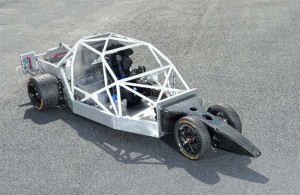The radical, dart-shaped DeltaWing race car has come “one step closer” to going street legal, the Georgia-based DeltaWing Technology Group says, with the unveiling of its DeltaWing GT Concept.
The highly aerodynamic design, based on the company’s Le Mans race car, would serve as the basis for a road-going, two-seat GT car. And DeltaWing hopes to follow it with a four-door sedan version, as well, it previously indicated.
“Real-world testing” is set to begin before the end of this year, DeltaWing announced in a statement, though its didn’t lay out production plans. The wind-cheating design and lightweight, spaceframe chassis would allow the GT to deliver sports car performance while still getting up to 74 miles per gallon, DeltaWing has estimated.
First seen on track during the 2012 running of the Le Mans endurance race, the concept behind the distinctive-looking DeltaWing focuses on light weight and advanced aerodynamics rather than massive amounts of horsepower.
(GM redefines itself as a “”personal mobility company.” Click Here to see what that means.”
Backed by Don Panoz, the Georgia-based entrepreneur and race team owner, DeltaWing Technology Group says preliminary testing shows it could deliver sporty performance – and more than 70 miles per gallon in a street car. If that were to hold up with a production model, it would rival the best of today’s hybrids and even more advanced plug-in hybrid vehicles.
“This is an important point in the DeltaWing project’s next phase,” said the 80-year-old Panoz, who serves as the company’s chairman and CEO, when an earlier street car prototype was unveiled last March.
The ultimate goal is to produce both a sporty GT model and a more mainstream four-seater.
The unusual design, which wraps around a lightweight spaceframe “architecture “can accept virtually any current or future transverse engine powertrain and deliver significant fuel savings and green benefits when compared to traditional vehicle designs,” the company claims.
It adds that, “The DeltaWing platform also can be fitted with all-electric or hybrid powertrains; today’s smaller and lighter high-efficiency gas, diesel and compressed natural gas (CNG) engines.”
(Mercedes takes aim at Tesla with 311-mile battery SUV. Click Here for the story.)
At least initially, the development program, led by engineering chief and racing veteran Brian Willis, has focused on a 1.4-liter, 138-horsepower four-cylinder gas engine. A preliminary analysis done by Meszler Engineering Services indicated an unadjusted EPA fuel economy rating of about 74 mpg Highway and 57 mpg in the Combined city/highway test.
That would put it well above the 54.5 mph target the EPA has set for the U.S. market in 2025 and would conceivably make it the most fuel-efficient gasoline vehicle on the road today. Only the three-wheeled Elio – which uses an equally radical shape and just three wheels – is targeting higher numbers.
Earlier this year, DeltaWing said it would cost about $60,000 for its two-seat, high-performance track model, the 350-horsepower GT. But it wants to bring the driveway-ready four-seater in for something closer to $30,000.
While the company says it is moving ahead rapidly on the project it hasn’t set a timetable for getting the DeltaWing on the road. Among other things, it still has to decide whether it will build the car itself or try to find a partner.
(Better late than never, after 2-year delay, Tesla launches Model X battery SUV. Click Herefor more.)



The Delta Wing race car did not impress and has been significantly redesigned several times. The street cars don’t seem to have much merit either despite the relatively low Cd. There are plenty of small fuel efficient engines that can be had in the Ford Fiesta, VW Polo or even smaller cars if that is what U.S. consumers desire but not that many people desire micro cars even with 40-50+ mpg.
Pretty cool. Since Polaris is making the reverse of this with their three wheeler but heading the other direction, how do the sizes compare to other classes of vehicles? If its got the same size of engine as my cruze yet gets double the mileage, then it comes down to intial price plus the price of fuel and what energy source. Something to look at.
Your Cruze has practical value and roominess. About all you can carry in a Delta Wing is the driver and passenger. It’s just a motorcycle with a roof on it. Not many people are going to pay $30K for one of these when they can buy a practical car for 2/3rds the price and have full service and resale value.
Looks about as large as a cruze without the frontal area. Since the cruze was the replacement for the cavalier yet a decrease in engine displacement from 2200cc to 1400cc with a turbo for the eco version. Yea GM markets the cruze in a next size segment from what they did the cavalier. Marketing, same car, more money. The 4 door version of the Delta of comparable getting double what the cruze gets 72mpg sounds good. Yes its not quite apples to apples. Doesnt or didnt VW market a 2 seat diesel coupe in europe that got 248mpg? Yes exotic materials limited production,engineering is always a compromise. Depends on wnergy forms and costs, and what is termed logical and practical. People save their classic hot rods for sunny days. Why no use their ultra mileage cars for special trips just a lot of american gear heads do? The average garage in my neighbor has places for three cars plus.
Not many people are likely to buy the Delta Wing as a commuter vehicle or single vehicle family due to all of the limitations – very similar to EVs.
Yes VW and others have developed motorcycle engine sized/powered high mpg vehicles. Every time the vehicle price goes up, it offsets any value in increased mpg as you are paying one way or the other. In many countries a family can only afford one vehicle so that is why small practical vehicles are the norm and something like the Delta Wing has no practical value. Having a delta Wing to drive on Sundays means it’s a toy, not the daily transportation vehicle.
The U.S. is the land of excess be it autos, house size, cellphones or whatever. Unfortunately many in the U.S. value quantity over quality and it shows.